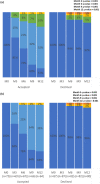Acceptability and retention of the key population-led HIV treatment service for men who have sex with men and transgender women living with HIV in Thailand
- PMID: 36757793
- PMCID: PMC9910427
- DOI: 10.1002/jia2.26062
Acceptability and retention of the key population-led HIV treatment service for men who have sex with men and transgender women living with HIV in Thailand
Abstract
Introduction: In Thailand, where the HIV epidemic is concentrated among key populations (KPs), particularly men who have sex with men (MSM) and transgender women (TGW), an HIV service delivery model tailored to KPs was piloted. This study evaluated the acceptability and retention of clients who accepted and declined the KP-led HIV treatment service.
Methods: A retrospective cohort study was conducted using secondary data from three community-based organizations (CBOs) and three hospitals in Thailand. KP lay providers were trained to lead HIV treatment service in which MSM and TGW living with HIV received counselling and a 3-month antiretroviral therapy (ART) supply at CBOs. Thai MSM and TGW who were at least 18 years, on ART for at least 6-12 months, without co-morbidities/co-infections, and virally suppressed were eligible and offered the service. Those who declined received ART via other service models offered by the hospitals and served as a comparison group.
Results: Of 220 clients screened between February 2019 and February 2020, 72% (159/220) were eligible of which 146 were MSM and 13 were TGW. Overall, 45% (72/159) accepted the KP-led service. Of those who declined, 98% (85/87) preferred to see the physician at the hospital. After 12 months of follow-up, among those accepted, 57% were in care at the CBO, 32% were referred back to and in care in other service models offered by the hospital, 10% were successfully transferred out to other hospital and 1% were lost to follow-up (LTFU); among those declined, 92% were in care in any service models offered by the hospital, 5% were successfully transferred out to other hospital, 2% were LTFU and 1% died (p-value<0.001).
Conclusions: Despite moderate acceptability and retention in care at the CBO among the clients accepting the KP-led service, almost all clients were engaged in care overall. Multiple service models that meet the preferences and needs of KPs living with HIV should be available to optimize engagement in care.
Keywords: HIV; Thailand; antiretroviral therapy; differentiated service delivery; men who have sex with men; transgender women.
© 2023 The Authors. Journal of the International AIDS Society published by John Wiley & Sons Ltd on behalf of the International AIDS Society.
Conflict of interest statement
All authors declare no competing interests related to this work.
Figures



References
-
- In Danger. UNAIDS Global AIDS Update 2022. Joint United Nations Programme on HIV/AIDS. 2022.
-
- HIV info hub [updated 19 April 2021, cited 23 September 2022]. Available from: https://hivhub.ddc.moph.go.th/epidemic.php
-
- Asia Region Operational Plan, ROP 2019: Strategic Direction Summary. U.S. President's Emergency Plan for AIDS Relief. 2019.
-
- UNAIDS Data 2021. UNAIDS; 2021.
-
- Thailand National Guidelines on HIV/AIDS Treatment and Prevention 2017. Bureau of AIDS, TB, and STIs, Department of Disease Control, Ministry of Public Health; 2017.
Publication types
MeSH terms
Grants and funding
LinkOut - more resources
Full Text Sources
Medical

